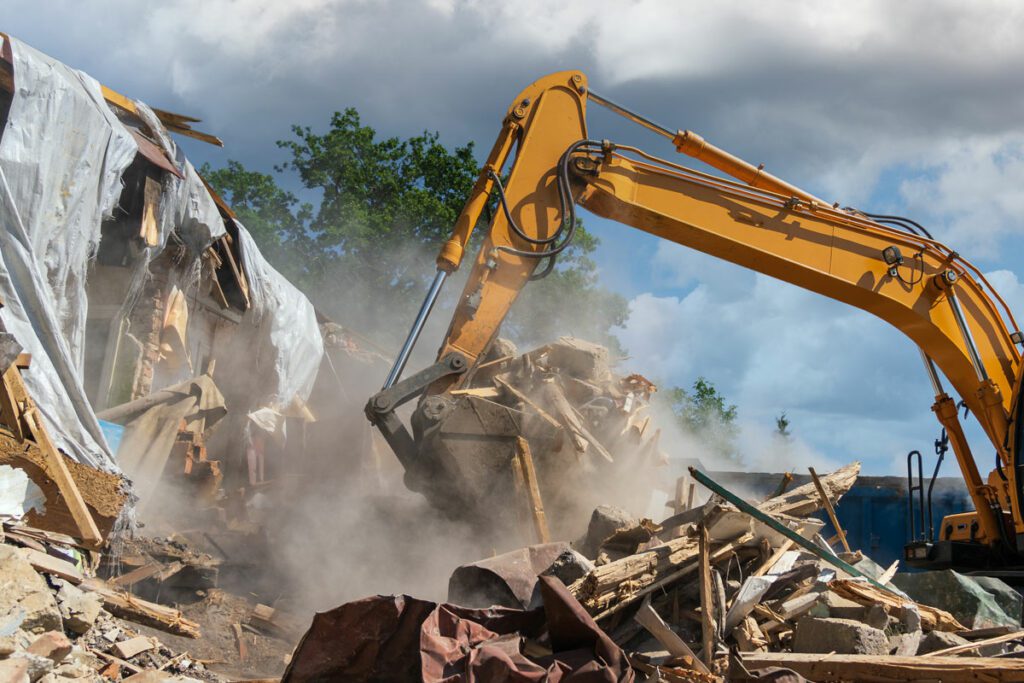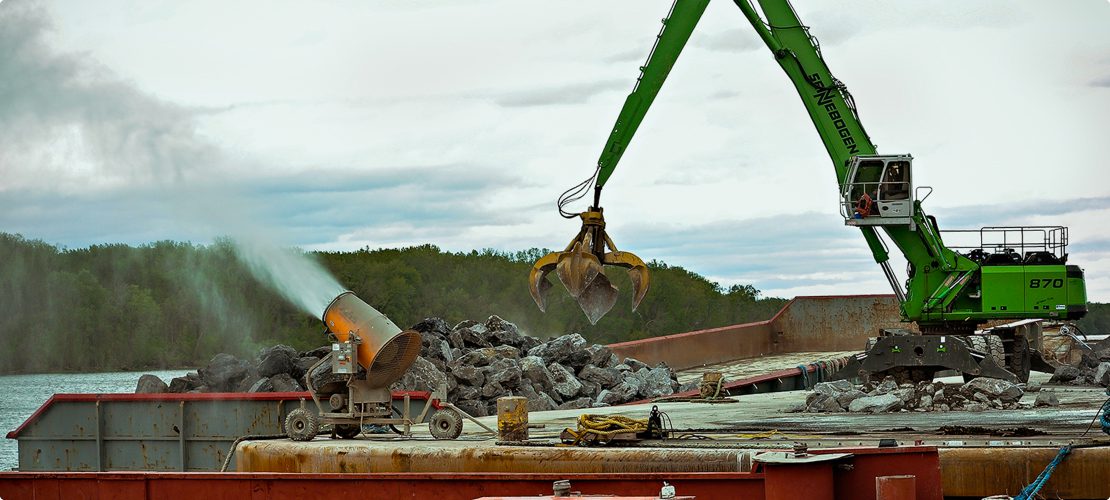
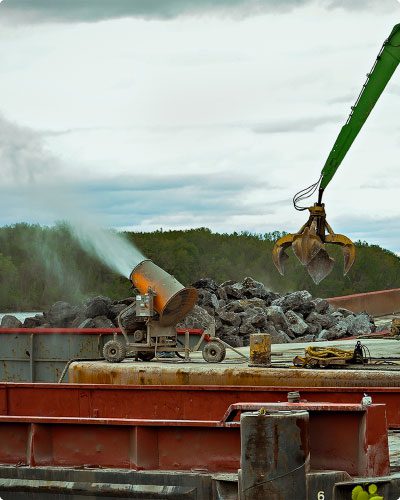
Wind currents seek the path of least resistance such as basins (rivers, bays, etc.). These are natural features that concentrate and amplify the airflow. Unfortunately, these areas also happen to be the location of ports handling dusty substances, from aggregate to grain, requiring managers and operators to seek dust suppression solutions for ports and terminals.[1]
Bays or inlets can offer excellent protection against the big waves and high winds from open bodies of water like oceans, the Great Lakes, or the Gulf of Mexico. However, many ports along main waterways and coastlines utilize jetties to control waves but have little protection from driving wind. Ports with bulk handling equipment such as conveyors, clamshell cranes, port hoppers, etc. find they must implement extra measures to control airborne dust as the material is moved through the loading and unloading process.
Moisture-sensitive raw materials commonly handled by ports like grain, petcoke, ash, etc. are almost always stored in silos, which act as a method of dust control. Other bulk materials that are less sensitive to wet weather like coal, aggregate, or recycling waste can be stored outdoors. Raw cargo sequestered into storage piles generally needs airborne suppression through the entire handling process. All these substances cause dust emissions when loaded and unloaded from ships. This is why port operators have been turning to DustBoss® from BossTek for a solution.
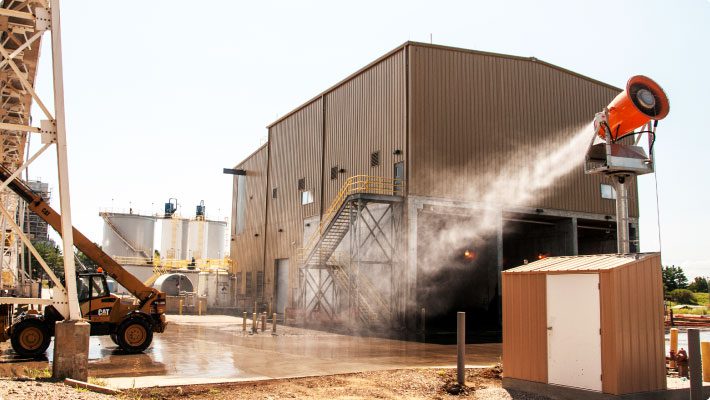
PORTS, WIND AND RUNOFF
The moment material is exposed to open air, it has a chance to shed dust. When it’s conveyed, transferred, piled, disrupted by machinery, or dropped from heights, tiny dust particles are lifted by air currents and travel past the site line. Most ports are affected by prevailing winds, so -- depending on the mass and size – airborne particulates can be carried long distances.[2] This can lead to violations of Occupational Safety and Health Administration (OSHA) Maritime emissions rules due to worker exposure to Respirable Crystalline Silica (RCS), heavy metals, allergens, and other controlled substances. Emissions can also elicit complaints from nearby communities to local branches of the Environmental Protection Agency (EPA), resulting in inspections and potential air quality violations.[3]
There are many dust suppression solutions, but the majority of dust mitigation techniques for outdoor applications require the use of water. Surface suppression (wetting the surface of the material to create a damp protective shell) is common but is not effective in high wind conditions or if the storage piles are constantly being disrupted. Currently, the only way to remove particulates from the air in outdoor applications is using atomized mist, where the pressurized water is fractured into droplets small enough to travel on air currents with the dust rather than fall to the ground like rain, as is the case with hoses and sprinklers. The fine mist must also be properly distributed over the area of emission, or it is not effective in the windy conditions common to ports.
Runoff is also a concern for any industry operating near waterways.[4] Ports have found that mist cannons use far less water and offer superior airborne dust control than standard water-based dust suppression systems. Hoses and water sprinklers – commonly used for surface suppression -- have been proven to offer little airborne dust suppression and create an excessive amount of standing water and runoff. This is due to how the water is delivered.
Handheld hoses or mounted sprinklers are connected to a hydrant and typically use 100-500 gpm (378-1892 lpm) to offer adequate surface dust control. The reason is they need the pressure of the water to propel the stream far enough to reach the height of the pile or ship and across the beam of a vessel. Due to water volume and overall effectiveness, it’s easy to see why port operators prefer dust control solutions like mist cannons.
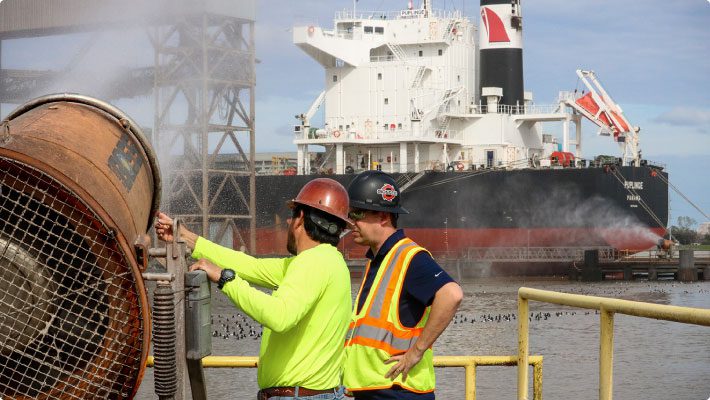
Atomized misting cannons use a standard hose to deliver water to a booster pump that increases pressure fed to a misting ring outfitted with special nozzles. Mounted on the front of a cone-shaped barrel, the misting ring fractures the water into millions of tiny droplets and a powerful rear fan propels the mist in a long-reaching cone. The volume of water depends on the size of the misting cannon. Ranging from the DustBoss DB-30 with a 100 ft (30 m) reach to the DustBoss DB-100 with a 328 ft (100 m) reach, units will only use a range of 4.9 gpm (18.5 lpm) to 39 gpm (147.6 lpm). A model like the DustBoss Surge® comes equipped with a wind resistant pressure spray nozzle that acts much like a hose or sprinkler with a 250 ft (75 m) reach but using a fraction of the water volume at 85 gpm (321 lpm).
READY FOR A QUOTE?
Talk to a dust control specialist and get a quick quote for your site.
POTABLE WATER VS. NON-POTABLE WATER
For atomized mist, it is best to use potable water but not entirely necessary. To use non-potable water from local ponds or waterways, port operators only need as little as 40 psi of pressure provided to the cannon. Water pulled from non-potable sources is first passed through the 575 mesh filter to avoid clogging the lines and misting heads. The water is then cycled through the booster pump to provide the pressure required for the atomizing nozzles to fracture the water into mist.
The use of non-potable may require more maintenance, including the periodic inspection of the misting ring and lines to prevent clogging and corrosion. A quick release manifold attaching the misting ring to the front of the cannon makes it easy to swap for cleaning.
Some operators who prefer potable water have mounted cannons on tanker trucks for fast access to most parts of the site. Ports can be square miles in size and have limited access to power, so BossTek offers the DustBoss Fusion™ line of equipment. The trailer-mounted units pair a DustBoss cannon with a genset to create a self-powered dust control system. This can be pulled by a smaller, more fuel-efficient vehicle, like a pickup, for versatile placement and mobility.
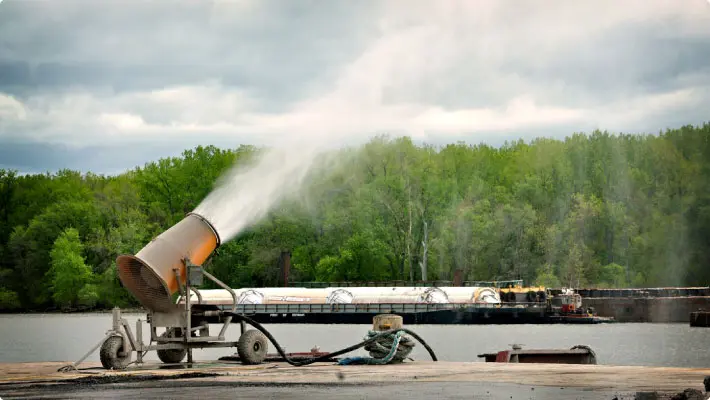
THE BEST DUST CONTROL CANNON FOR PORTS
Ports with a singular (or limited) function such as a grain or coal terminal can have fixed dust suppression solutions throughout the closed system. Other ports don’t have this luxury. A port with more material-agnostic operations might require a completely open bulk handling system from train/truck to storage to the ship, with a dust solution needed at every stage.
As a new type of material is introduced for handling, along with it comes a new set of obstacles in preventing dust particle emissions. A large nearby demolition project, for example, can suddenly be a lucrative source of scrap and recycled material from metal to concrete, but each material has different handling, storage, and emissions needs.
The throughput of raw port cargo begins at offloading to the site by train or truck and ends the moment the material hits the deck or hold of a vessel. From a dust control standpoint, several methods may be employed to achieve tailored dust control solutions.
- Misting Rings: Material discharged from a conveyor is usually, at some point, exposed to wind. By using a stainless-steel DustBoss DB-Ring, the material flow is surrounded by a curtain of light mist that falls with the material, and fugitive emissions are prevented from traveling.
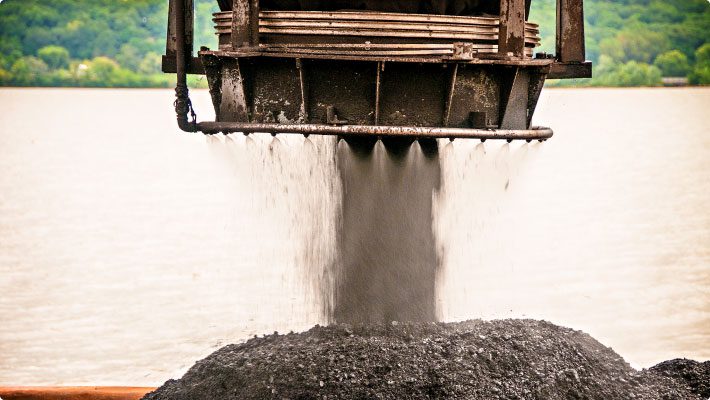
- Misting Heads: Discharged material at conveyor transfer points will separate, offering an excellent opportunity to introduce moisture from strategically placed misting heads. The DustBoss® DB-M Mini is a directional misting head. This option can be accompanied by a dosing system to introduce dust suppressing surfactants to mitigate downstream dust emissions.
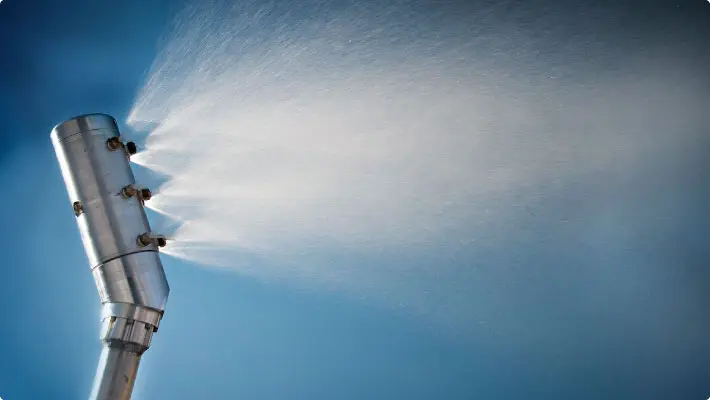
- Tower Mounted Dust Cannons: Consistent disruption from front loaders on stockpiles can cause dust to become airborne. Since stockpiles are generally designated areas, operators have mounted cannons to a carbon steel, hot dip galvanized tower ranging up to 20 feet in height. The higher reach extends the atomized misting plume and creates a ceiling that suppresses the lift of particles.
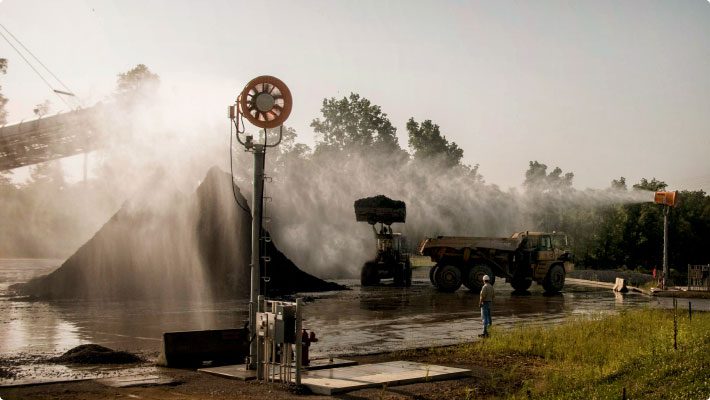
- Mobile Dust Control Cannons: Mounted on a skid or mobile carriage, using optional oscillation and a 0-50º vertical throw angle, dust cannons distribute millions of fine dust-suppressing water droplets over a large area. The mobility allows it to be easily relocated to fight dust wherever needed. Based on the maximum ship size allowed by the port, operators can choose DustBoss models (DB-30, DB-60, DB-100) that reach the height of an empty ship with enough power to stretch across the beam. A benefit of mobile cannons is that they can be easily moved to material storage or loading areas when not in use at the port.
- Specialized Dust Suppression: As previously mentioned, windy situations require the versatility of the DB-60 Surge which features a high-flow center nozzle to deliver a concentrated stream of water. Like the standard misting cannons, it uses a booster pump rather than water volume to create enough pressure to shoot a powerful stream over long distances using a fraction of the water of hoses or sprinklers.
CASE STUDY: PORT OF PANAMA CITY, FLORIDA
The Panama City Port Authority in Florida needed a dust suppression solution for its wood pellet loading operation to help retain high air quality. “We maintain an 80,000 sq foot warehouse used exclusively for storing wood pellets, which are a widely used biomass fuel in Europe,” explained John Ramer, Director of Terminal Services. “The facility receives about 30,000 metric tons of pellets each month by rail car, creating stockpiles more than 100 feet wide at the base, with an enormous potential for dust,” he said.
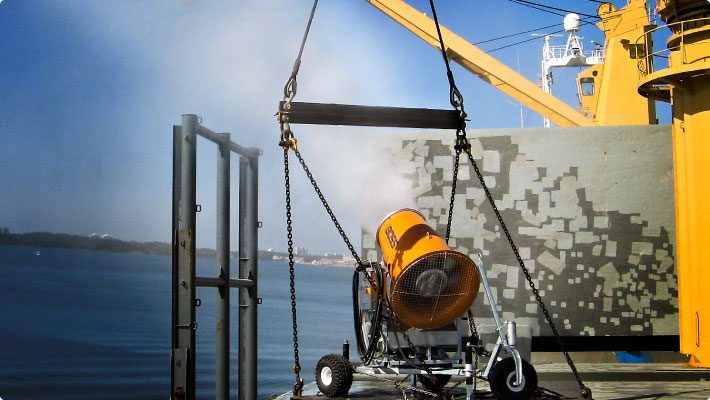
To control the inevitable dust from three front loaders with 10-yard buckets feeding a 600-foot conveyor and then dumping such a huge volume of pellets into a ship’s hold, Ramer knew that he’d need specialized equipment designed specifically for that purpose. “If the pellets get wet, they tend to crumble, so we had to avoid spraying any water down into the hold,” he added.
Operators chose a mid-sized atomized mist cannon. “Once we started working, we aimed the plume of water mist into the dust cloud, and it made an immediate difference,” Ramer said. He estimated that dock workers can load about 1,000 metric tons of material per hour. Port officials reported that the equipment has been very efficient, helping to protect ambient air quality and prevent negative effects on workers, as well as local residents and manufacturing operations.
As it happened, shortly after implementing atomized mist, the port got a visit from the Department of Environmental Protection. The agency representative was impressed with the particle control methods at the site and departed without issuing any notices or warnings about dust.
PORT DUST SUPPRESSION SOLUTIONS
A comprehensive dust management plan should be a substantial section of any port’s environmental impact assessment (EIA). These reports generally involve a thorough evaluation of air and water quality in and around the port, revealing where dust emissions originate and identifying other potential issues that need to be addressed.
Port operators in areas with strict air quality standards can find it difficult to stay compliant, but with the right dust control technology and approach, each unique situation has a solution. Contact Us and speak to a dust control specialist to help your organization formulate a robust dust control plan for your EIA. Let our experience in ports of all kinds help you determine the best way to mitigate dust emissions and remain compliant.
IMPLEMENT DUST SUPPRESSION SOLUTIONS AT YOUR PORT!
Receive a quick quote and talk to a dust control specialist today!
